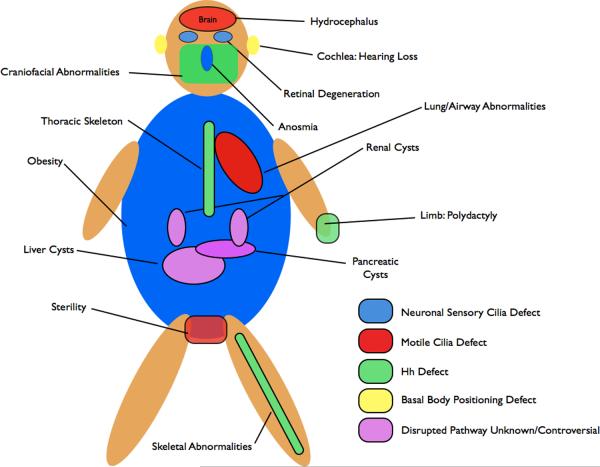Box 1. Organs affected in human ciliopathies.
Numerous pleiotropic human disorders have been attributed to defects in cilia formation10, 135. Some aspects of these syndromes, such as the polydactyly in patients with Bardet-Biedl syndrome (BBS) and Meckel Syndrome (MKS) and the skeletal abnormalities affecting the limbs in Ellis-van Creveld are attributed to defective Hh signaling. Polydactyly results from a loss of Gli3R and skeletal abnormalities resemble those observed in mutants that lack Ihh signaling136. Shh signaling is also required for craniofacial development, and defects in craniofacial structures, such as those observed in Mks1 mutant mice, are also likely due to mis-regulated Hh signaling32. In addition, patients with a Joubert syndrome-like disorder exhibit ataxia due to cerebellar hypoplasia137. Growth of this tissue is Hh dependent85. Other attributes of human disorders result from defective specialized cilia. Retinal degeneration results from defects to photoreceptor cilia, which connect the outer light-responsive segment to the cell body. Detection of odorants depends on the primary cilia of sensory neurons in the olfactory epithelium and BBS patients often exhibit anosmia138–140. Another sensory deficit, hearing loss, is due to a requirement for the specialized primary cilia of the cochlea downstream of the PCP pathway in establishing the correct polarity of sensory hair cells99. Infertility observed in patients with ciliopathies is the result of defective motile cilia of spermatids or oviducts139.
For some of the most severe and common abnormalities associated with ciliopathies, such as cyst formation in the kidneys, liver, biliary duct and pancreas, the underlying molecular causes downstream of the cilium remain unclear. Cyst formation is thought to result from defects in cell proliferation or mis-orientation of the mitotic spindle, however, whether and how these processes are regulated by cilia remain the subject of active investigation124. In addition, BBS patients often exhibit obesity and cognative impairments thought to be due to neuronal defects, however the specific pathways responsible for these attributes in BBS patients have not been clearly identified141, 142.

